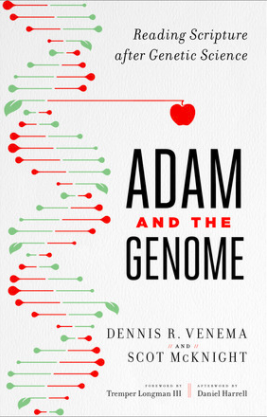 Adam and the Genome Books are officially available tomorrow. Clips from the first chapter in the second half of the book.
Adam and the Genome Books are officially available tomorrow. Clips from the first chapter in the second half of the book.
Principle 1: A text out of context is a pretext.
Every statement about Adam and Eve in the Old Testament, in Jewish literature, and in the New Testament is a statement made from a context and into a context. Furthermore, some of the statements about Adam and Eve in all of this literature are designed to speak against that context. That is, those statements are polemics and apologetics. Learning about those contexts and that polemic often bring fresh understanding of the intention of the Bible and hence of what God wants his people to hear. In addition, this contextual approach to Adam and Eve provides a model for how Christians today can think about Adam and Eve in the context of the faith and science debate. If the Genome Project provides brilliant discoveries about the origin of life and the development of humans into who we are today, we will all gain clarity if Christians learn how to speak about Adam and Eve in a context that both affirms conclusions about the genome as well as challenges some conclusions drawn from the Genome Project. Contexts, both ancient and modern, shape what we see, what we hear, and how we respond.
Principle 2: Respect
This text came on the scene in the Ancient Near East and Genesis 1—11 sounds like that world, it uses categories and terms and ideas from that world, and not least it has the “pre” scientific assumptions of that world. We must respect that text as designed for the Ancient Near Eastern culture. What we have learned from specialists in the ANE creation stories is that these stories did double duty: they explored the (largely mythic) “past” but also were designed to speak into the present. They were, in other words, some kind of history and some kind of theology mixed with one another. Old Testament specialist Joseph Blenkinsopp takes us to the heart of what these ANE texts were designed to do:
These ancient stories were not written to entertain. Those who first set them down in writing may have been curious about the remote past, but historical curiosity was not their main purpose in writing. Rather, the creation of narratives, active genealogies of gods and mortals, and dramas featuring characters and situations set in the remote past provided their authors with a vehicle for thinking through basic issues, for expressing convictions and ideas about life in the present, the life of their societies and, no doubt, their own individual lives as well. We should expect to find something comparable in the biblical history of cosmic and human origins.
The most respectful reading knows this double-duty feature of the ANE creation narratives, and it gives the same respect to the Bible’s own account: it, too, is doing double duty.
Principle 3: Honesty
In the topic of this book we need to be honest about two things: the Bible and science. As a professor I teach my students this method: face the facts and do not fear the facts. I believe this means we have to face both what the Bible teaches and what science teaches. So we are right back with our two facts: science’s view that human DNA goes back to more than two people and the Bible’s apparent teaching that it all goes back to two people, Adam (and Eve). So we face the facts. The Bible really does make it look like Adam and Eve are humans from whom we descend. But scientists are going to tell us straightaway that Adam and Eve themselves had ancestors, reminding me of an old grave I walked into just outside Johannesburg South Africa in what is called “The Cradle of Humankind.” Here I encountered places and pictures where they discovered hominin fossils dated at 2-4 million years. Others are going to tell us that the DNA make-up of humans today goes back to thousands of hominins and on and on… so we come to this point and it is for me the most significant pastoral question pastors need to ask in tandem with scientists: Are you willing to face the facts, the facts of the Bible and the facts of science?
Principle 4: Sensitive to Science Students
Everything we teach about Genesis 1—11 needs to be examined, pondered, and thought through with respect to contemporary students of science. By students I mean students nurtured in Christians homes, churches and under the tutelage of public school teachers. Which means they hear the Bible in one context and science and evolution in another (and sometimes hostile) context, and it is they who are put in the hot box Monday through Friday in front of their peers and before teachers who will grade their papers and assess their intelligence. While pulling students out of the public school system may suspend the tension, eventually the student will experience the raw capacity of evolutionary theory to explain scientific realities.
Let’s be honest again. Here’s the common theology at work in the mind of the kind of student about whom we are concerned: God made Adam and Eve directly, out of the dust. That primal couple sinned, and death first entered into the world through their sin. Adam is almost entirely absent from the Old Testament and so the next really important text (for our purposes) is either Romans 5:12-21 or 1 Corinthians 15:21-22. Nuances aside, Paul contends that as sin and death entered into the world through one man, Adam, so righteousness and life enter back into the world through one man, Christ. Salvation then is wrapped in one interpretation of Adam. We can ramp this up one notch: Luke has a genealogy that runs from Jesus all the back to Adam. This means Adam is “historical” and this means the Bible tells the true story about history and origins. Those are assumed to be the Bible’s scientific and theological facts. This becomes the template for understanding the Bible and for reality, and any threat to that template receives serious blowback. Which works out as back-logic: if Christ is real, then Adam is real, and also if Adam isn’t real, then the whole thing falls apart. This is what was at work in my student’s worldview as he struggled with what he was learning in biology.
Principle 5: Prima Scriptura.
Christians affirm the Bible as God’s revelation to God’s people. This is sometimes called the Scripture Principle while others use the Latin words of the Reformation: sola scriptura. A slight but important modification it to turn sola into prima scriptura so that we affirm first of all what the Bible says.




